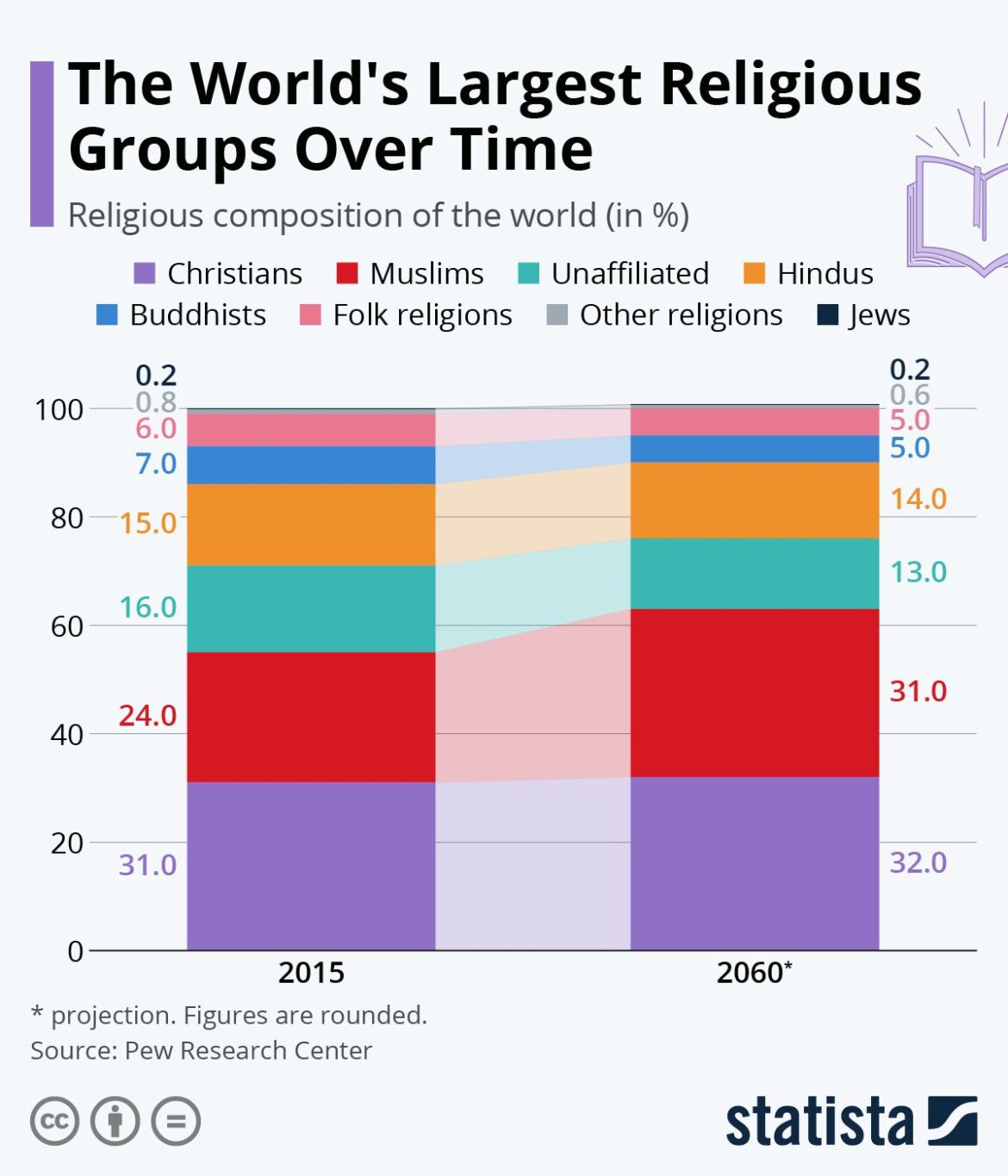The question of which religion holds the status of the largest in the world is not merely quantitative; it invites a myriad of reflective inquiries and challenges. What does it truly mean to be part of a faith tradition that embraces billions? How do numbers shape our understanding of spirituality? These questions beckon exploration beyond mere statistics into the profound implications of religious adherence.
As of recent estimations, Christianity stands as the largest religion globally, encompassing over two billion adherents. This staggering figure represents not only individuals who attend services regularly but also those who may identify culturally or ancestrally with Christianity, making it a vast and diverse faith community. However, the sheer number of followers raises an interesting challenge: does size equate to authenticity or truth in religious experience? This inquiry becomes critical as we navigate the cultural and spiritual landscapes in which Christianity finds itself juxtaposed against other major world religions.
In exploring the demographics of global faith, it is essential to acknowledge the historical roots of Christianity. Emerging from 1st-century Judea, it has undergone profound transformations. Early Christians faced persecution, but the faith flourished, adapting to various cultural contexts. Fast forward to today, Christianity manifests in numerous denominations, including Roman Catholicism, Protestantism, and Eastern Orthodoxy, each embodying unique theological perspectives, practices, and traditions.
But let us not be lulled into complacency by numerical supremacy. The growth patterns of Christianity paint a fascinating picture. In regions such as sub-Saharan Africa and parts of Asia, Christianity is experiencing remarkable growth, often characterized by vibrant enthusiasm and grassroots movements. Conversely, in the Western world, particularly in Europe and North America, many nations are witnessing a decline in religious affiliation, signifying a shift towards secularism or spiritual but not religious identities. This brings forth an engaging paradox: what does it mean for a faith to grow numerically while simultaneously undergoing a crisis of relevance in certain contexts?
Moreover, it is critical to consider the multi-faceted nature of global faith landscapes. Behind the formidable numbers tied to Christianity lie other major religions such as Islam, Hinduism, and Buddhism, each also boasting immense followings and rich traditions. Islam, for instance, closely follows Christianity in terms of global adherents, with approximately 1.9 billion Muslims worldwide. The expanding demographic of Islam, particularly in diverse and multicultural societies, presents both opportunities and challenges for interfaith dialogue and understanding.
In this milieu, one might propose another challenge: how do adherents of each faith navigate the realities of pluralism? The modern world, with its rapid communication and globalization, invites Christians into engagement with myriad beliefs and practices. The notion of exclusivity can either polarize or propel interfaith interactions; these conversations can enhance one’s understanding of the divine or, conversely, create schisms. An opportunity arises here—a chance to reflect on shared human values while remaining steadfast in one’s faith convictions.
From a Christian perspective, examining the growth of other religions serves as a call to revival and introspection. How does Christianity proclaim its message in an increasingly skeptical, pluralistic society? Engaging with this question can catalyze a deeper commitment to authentic spiritual living, as believers may ponder how to demonstrate the love of Christ through actions rather than mere words.
The numerical strength of Christianity, while significant, presents an important theological prospect as well. The message of reconciliation, grace, and love can be profoundly compelling, suggesting that the heart of Christianity carries an inherent transformative quality. Therefore, how believers respond to the spiritual desolation observed in many lives becomes critical in addressing the perceived disconnect between divine truth and real-life application.
Additionally, the role of technology and social media shapes contemporary faith expression. Both a gift and a challenge, these platforms enable vast outreach possibilities. Live-streamed services, online theology courses, and global mission initiatives thrive in digital spaces. However, do they encourage genuine engagement with God, or do they risk relegating faith to superficial “likes” and “shares”? Thus emerges the question of authenticity in an age of digital religiosity, as believers navigate their faith in both corporeal and virtual realms.
Furthermore, the socio-political implications of being part of the largest religion cannot be understated. With influence comes responsibility, particularly as Christians are called to advocate for justice, equality, and peace. In a world rife with division, how can those claiming to follow the teachings of Christ embody a spirit of compassion that transcends cultural and religious boundaries? This question reverberates as society looks to believers for leadership amid tumultuous times.
In conclusion, the answer to the query of the largest religion in the world extends beyond an affirmation of numerical supremacy. Christianity, with its vast, variegated tapestry of beliefs and practices, stands as a pivotal force in the global religious sphere. However, it is essential to cultivate an understanding of faith that is as dynamic as the world itself—one that acknowledges both the challenges and the joys of spiritual identity in a pluralistic age. Ultimately, whether one finds solace in the embrace of the Christian tradition or in the exploration of other faiths, the journey towards understanding and connection remains a sacred enterprise. And therein lies the invitation to ponder: in a world so rich with diversity, how can one live out their faith with integrity, humility, and love?



